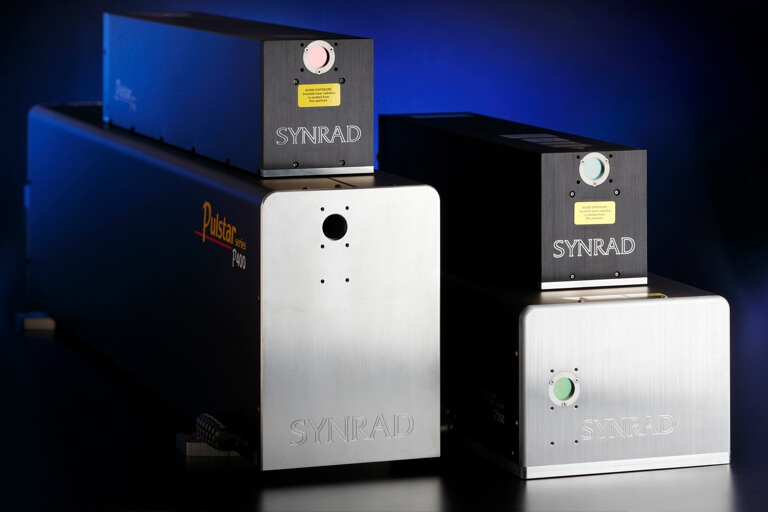What do you need to consider when selecting the best CO2 laser for your application?
Lauren Knollmeyer, Synrad’s Market Analyst, goes through the important aspects including laser performance specifications, cooling methods, and beam delivery.
Click link to find out more about the Synrad range of CO2 lasers…
Here is a very interesting and informative overview of CO2 Lasers, written by Synrad:
 More About CO2 Lasers
More About CO2 Lasers
Lasers are precision tools that generate light efficiently focused to a very fine spot. There are different types of lasers based on various materials or laser generating technology each having its own advantages and disadvantages. Lasers offer significant advantages over traditional mechanical processes:
- Unmatched precision – with focused spot sizes as small as 116 μm (0.005”) and the ability to concentrate the effect on specific areas of layered materials lasers are unique in their processing capabilities
- No damage to target materials – lasers do not come into contact with the target material, only the concentrated beam does, completely avoiding unintended damage caused by touching, dragging, or tearing the target material surface
- Significant reduction in machine downtime – lasers do not contain mechanical or moving parts that are subject to wear or breakdown avoiding costly down times due to mechanical failure
- Reduced maintenance costs – lasers do not contain consumable parts to replace and do not require traditional maintenance associated with mechanical systems
- Low operating costs – the combination of low power consumption, reduced maintenance, reduced material waste, and elimination of complex mechanical set-ups associated with project change overs result in significant savings in operating costs
Lasers function as components within a system, much like an engine for an automobile, and needs additional components to deliver the laser beam to the target material to achieve the desired effect. No single laser is suitable for all applications because it cannot accommodate the key variables associated with a variety of target materials and the desired effect. Simply put, to ensure optimal performance match the laser to the specific application and target material.
Flowing-gas CO2 lasers have been the industrial workhorses since the 1970s, helping pioneer the use of lasers in the aerospace and automotive industries. However, their size, gas consumption and ongoing maintenance requirements have presented significant challenges for many users.
All-Metal Tube Advantages
Since their introduction into the industrial marketplace almost 30 years ago, sealed carbon dioxide (CO2) gas lasers have established themselves as standard equipment in a number of industries, including manufacturing, marking/coding, cutting, packaging, and have specific medical/dental applications. Sealed CO2 lasers offer industrial users the benefits of a high quality laser beam from a compact, lightweight, rugged unit with operating lifetimes in excess of 35,000 hours. For industrial applications sealed CO2 lasers are easily integrated mounted on robotic arms, moving-gantry systems, and x-mounted on production assembly/processing lines with near maintenance-free operation.
Several types of sealed CO2 lasers are available with the main difference being the type of tube used to house the lasing medium or the CO2. Today three (3) types of material make up the vast majority of laser tubes, glass, ceramic, and metal. Synrad uses a patented all-metal tube design to ensure high laser gas purity and durability in challenging industrial environments. The result is consistent delivery of a high quality laser beam over a long period with little to no maintenance. Once the laser reaches the end of its useful life, a simple and inexpensive gas refill restores the laser to full power.
Low-power lasers
For a low-power (< 100 Watts) laser a glass tube is a low cost option, however there are significant disadvantages:
- Lacks Durability – glass by its own nature is far more fragile than metal and subject to breakage due to movement and during transport. In industrial environments, tough physical durability is a distinct advantage since transportation and movement is often in a less-than cautious manner.
- Too Long – unlike Synrad’s all metal tube designs, glass lasers house their laser mediums in a straight line, which increases dramatically with the power (watt) of the laser. Synrad’s metal tubes utilize proprietary designs that shorten the length of the laser. Consequently, glass tubes cannot cost effectively use this same shaping technique and thereby need to design their systems in straight configuration.
- Shortened Lifespan – maintaining gas pressure within the sealed tube is paramount to the laser’s performance and operation. Glass tubes lasers commonly leak gas through seal points between the glass tube and their metal connectors because the gas within the tube is under pressure and overtime the seal points will degrade and eventually leak. Further, the compounds used as sealers can react negatively with the gas mixture in the tube causing enough change in the mixture that affects the laser’s performance.
- Higher Total Cost of Ownership – the fragile nature and shorten lifespan of glass tubes will result in more frequent downtime resulting from replacement of the glass tube laser, compounded by the resulting downtime and increased service labor the total cost of ownership will be higher when compared to Synrad’s All-Metal tube design.
Low-power lasers with glass tubes may offer advantages of low entry cost; however, the overriding considerations of durability, performance and total cost of ownership could outweigh the cost savings. If the application requires high accuracy, high volume and is expected to continue over a long period a laser with a glass tube would not be the best choice.
Mid-power lasers
When considering mid-power (100 Watts – 1 kilo Watt) laser options tube design becomes even more critical because the impact goes beyond the tube itself and the laser optics become an added focal point. Lasers optics are extremely sensitive and even tiny amounts of debris caught in the sealed tube dramatically affects the laser’s performance if the debris interferes with the laser optics.
For mid-power (100 Watts to 1 kilo Watt) lasers ceramic tubes are an alternative option, however there are significant points to consider:
- Unwanted Power Absorption – the typical beam wavelength generated by a sealed gas laser is 10.6 μm, however a different wavelength may be required for a specific application. Ceramic tubes absorb light in specific wavelengths that result in a loss of power delivered by the laser. To offset the power loss lasers with ceramic tubes have higher power levels than Synrad lasers with All-Metal tubes at wavelengths below 10.6 μm. This means ceramic tube lasers will consume more power per Watt than Synrad All Metal tube lasers at wavelengths below 10.6 μm.
- Structural Failure – the extrusion and ring processes used in manufacturing ceramic tubes can result in micro fractures and/or cracking that create leak points for the gas and potentially failure of the tube. These micro fractures and cracks can worsen over time due to normal heating and cooling of the laser tube that occurs during operation.
- Contamination – to check for cracks and micro fractures a penetrating die is commonly used during the inspection process. The penetrating die will react with the laser gas if not thoroughly removed after the inspection process causing poor performance of the laser. Another source of contamination is particulates trapped inside the tube. The fine silica used in the manufacture of ceramic tubes when trapped in the sealed tube can destroy the precision optics found at either end of the tube, and this is especially a problem with vertically mounted lasers.
Ceramic tubes may have a place among laser tube materials, however the focus here needs to be on manufacturing processes that ensure tube integrity and prevents contamination.
The All Metal tube technology is the heart of Synrad’s laser design and a significant design contributor to its reliability. The All Metal tube technology is time tested having operated under demanding environmental conditions in excess of 45,000 hours and still going. Synrad engineered a rugged laser tube that ensures gas purity, and manufactures it with exacting processes to deliver a consistent, high quality beam for reliable performance year after year.
![]()

